Which could have become a Swedish Bastille
June 20 , 1810. The day that definitively put an end to the extravagance of the Gustavian era. With a budding democracy, on the way to a more equal Sweden. Although the chaos was close to a revolution, like in Paris.
- Who was behind the drive against the von Fersen siblings?
- Crown Prince Karl August poisoned?
- Without the French giant bribe, no Bernadotte on the throne?
The peace of 1809 was bought at a high price. The kingdom was amputated by a third. The economy was in chaos and many feared that the country would be cut up by the great powers, as in Poland. The lower nobility revolted against the aristocracy and kicked out Gustav IV Adolf. The new form of government opened up a spring flood of pamphlets that incited broad sections of the people.
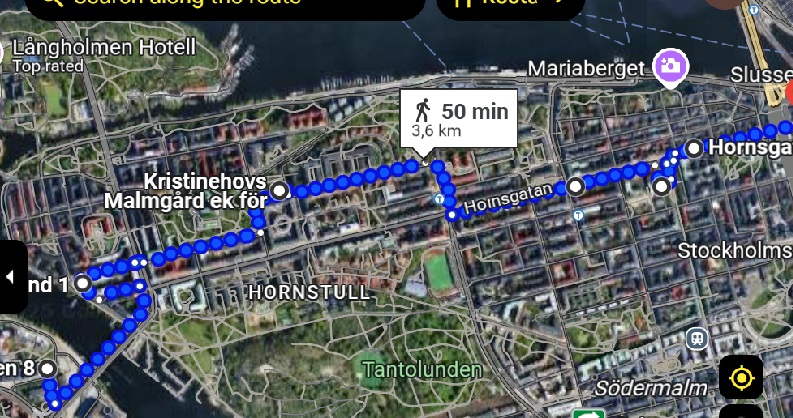
Could the murder of Count Axel Fersen have been a spark for the people’s bloody revolution, like in France? Riddarhustorget a Swedish Bastille?

Despite nine hundred interrogations, it was not clear which forces were behind it. Who was behind the distribution of rebellious leaflets, the fake news of the time in social media. And who financed the ducat distribution and free alcohol in the taverns? The questions are raised during the walk through Södermalm and in the Old Town.

Stop 1. Liljeholmen’s former inn (approximately Liljeholmsvägen 8).
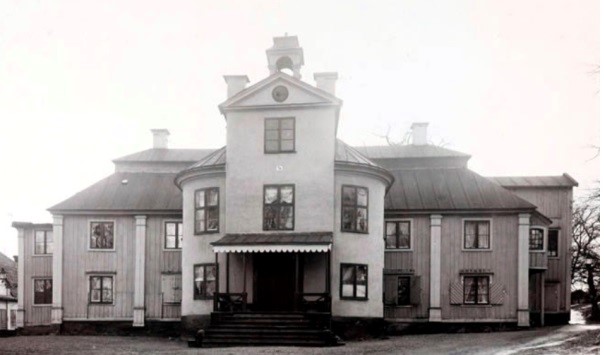
Only a few lime trees remain after Liljeholmen’s inn, which was demolished for a station house in 1901. And then paved for the E4. Originally built as a hunting lodge in the Carolingian style for Queen Kristina. Followed by the inn, frequented by the poet Lasse Lucidor. With a good location for those thirsty by land and sea, by the Mälarinfarten and Södertäljevägen.
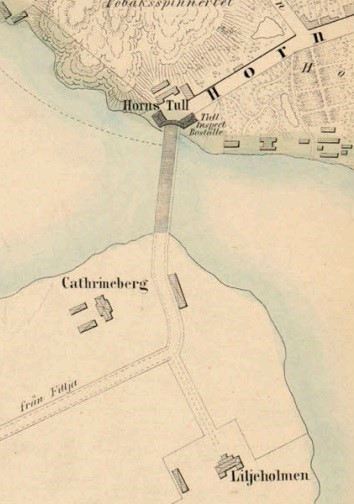
June 20, 1810 after 10 a.m. An unusually cold and windy day for midsummer. After spending the night at Salem Church, the carriages with the dead Crown Prince Karl August roll into the Liljeholmen inn. The carriages are worn and dusty. 25 hussars escort – tired after the week-long journey from Skåne.
During the stops at the vicarages, farmers had offered to pull the hearse, which was then brought from Germany with the remains of Gustav II Adolf. For the unassuming Karl August was as loved as the nobles were hated. Not least for the heavy duty of pulling.
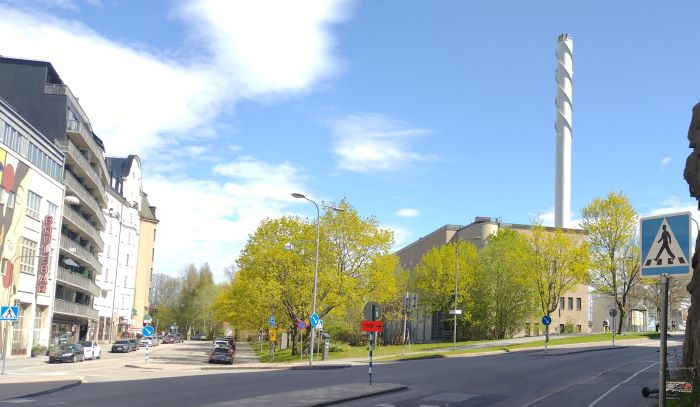
The Life Guards’ riders arrive from Södermalm together with court dignitaries and lackeys. After eleven, Count Axel von Fersen arrives with his brother Fabian. As Marshal of the Realm, he inspects that the train is properly arranged according to court etiquette.

The coachman has a pre-sports unrest in the city and warns Fersen to get into the gala carriage. The count was advised not to follow the train, an anonymous letter in the morning. Warnings that he also received when he went to the main seat from his castle in Östergörland on June 5. A good alibi if it were not for the widespread belief that the crown prince had been poisoned by the physician Rossi, sent to Skåne by the Fersen siblings.

Liljeholmen was located below Årstagård. Årstagård’s wife Märta Helena Reenstierna got married at the inn and often had her horse brought there. Bellman was also a guest. On the way to his sister at Hägerstens farm, the horse fell in Nybohovsbacken. Whereupon Bellman wrote in the tavern, ” Uppå Lord’s rest day I and my fellow rest. The chaise lies in the ditch ; The horse in Karon’s kingdom , and on Liljeholmen I”.
More about Årsta and Årstafrun in StockholmsMix. Click.
August Strindberg reveals in The Handmaid’s Son his tangled origins, traced to Liljeholmen:
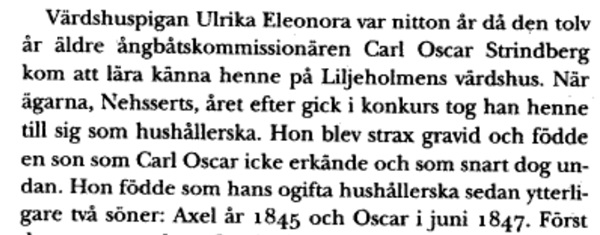
Stop 2. Hornstullsstrand 1. The wooden bridge from Liljeholmen landed where we see the bathhouse barge.
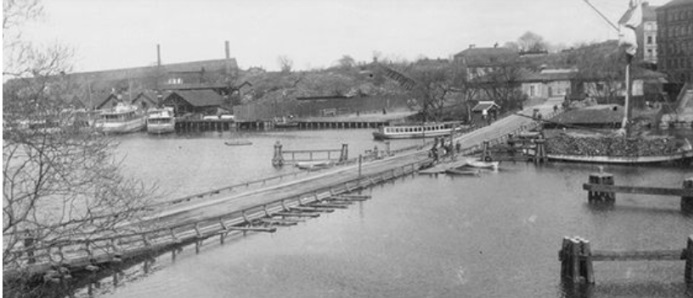
The walk along Liljeholmsviken should ideally be done on a sunny day, not cold and windy like June 20, 1810. Enjoy the wall painting and an ice cream at an outdoor café. Södermalm stands out like a horn, hence the name. Hornstull continued on Hornstullsgatan, now renamed Bergsunds strand and Hornsbuksgatan after a medieval brickworks. About there, by the bathhouse barge, was the Liljeholmsbron – since the 17th century the city’s exit to the south.
At noon, Crown Prince Karl August’s funeral procession can be seen carefully making its way across the narrow wooden bridge over Liljeholmsviken. It bends under the heavy carriages and water seeps into the cracks.
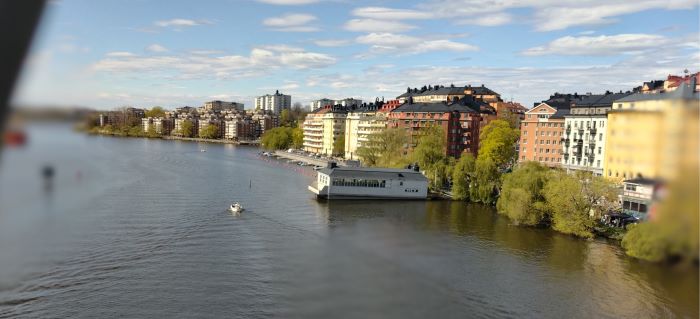
First come fifty horsemen from the Life Guards. Then carriages with court dignitaries drawn by one or two skirmishers.

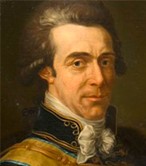
Following the court dress follows a gleaming carriage. It is drawn by six white horses led by liveried lackeys. Eight servants surround the carriage with a gilded count’s crown on the roof. Behind the windows, a man with orders and ribbons on top of his black coat can be seen. Axel von Fersen, still tall but his hair is unusually gray for his 54 years. The marshal’s baton with a mourning tuft is a symbol that after the royals he is the most powerful in the castle.
Four black horses pull the old hearse closely behind Fersen’s carriage. Four riders hold the corners of the coffin cover, dusty after the long journey from Skåne. As unpretentious as Karl August himself, which made him immensely popular in wide circles. First with the name Christian August as a kind of Danish viceroy in Norway. After arriving in Sweden in January 1809, he was praised for his modest habits. Wise and substantial but awkward around women according to Queen Hedvig Elisabet Charlotta.
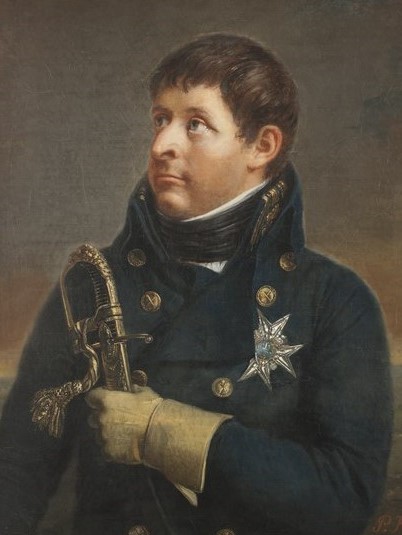
The symbolism could not be clearer. The train marks a turning point between Gustavian extravagance and a more modest Sweden. From autocracy and privileged aristocracy to a more egalitarian one. With an approach to democracy, in the form of government nailed by the Riksdag on June 6, 1809.

Intermediate stitch
In December 1808, peace was made with the Danes, where Prince Christian August , as a kind of Norwegian viceroy, had led the war against Sweden. The unfortunate monarch Gustav IV Adolf was dethroned and kingdom in May 1809. Replaced by his uncle Duke Charles, crowned number XIII. The peace of Fredrikshamn in September 1809 was bought dearly, with the loss of Finland, Åland and Lapland east of the Torne River.
How to win Sweden back within the borders of the kingdom? Ally the kingdom with Norway! Letting the childless Charles XIII adopt the Danish prince Christian Augustus seemed like a smart move. A royal union in sight with Norway and perhaps even Denmark, like the medieval Kalmar Union.
A fable about the fox and the vixen in Nya posten was widely circulated. It was not difficult to see that it was the Fersen siblings who intended to kill the Crown Prince. Flyers, printed and handwritten, were distributed in Stockholm. Some were available to read in the taverns and others were put up on the walls.
Karl August’s health deteriorated during the trip to see the military maneuvers in Scania. Fabian von Fersen sent the life physician Rossi, who tried to cure the heir to the throne, first to Karlskrona until he fell from his horse and died. There he witnessed exercises on Kvidinge heath on the 28th. Before that, Karl August had met his brother Frederik Christian in Helsingborg – a few miles from Denmark from where Jean Baptiste Bernadotte had planned to invade Scania two years earlier. Three crown princes were recruited from the enemy, because Frederik was also considered as heir to the throne before Bernadotte was chosen.
Stop 3. Hornstull rural idyll where a funeral procession became a farce
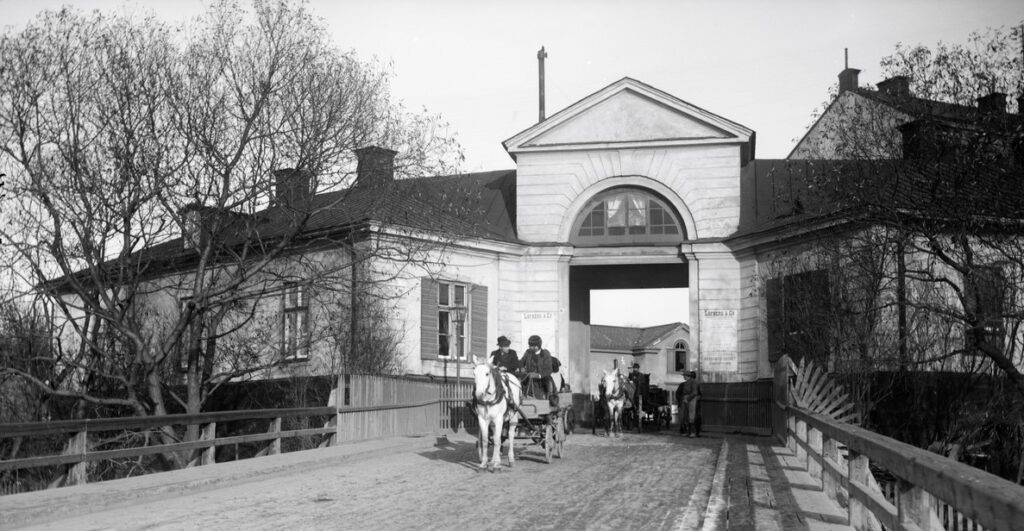
After the bridge, the funeral procession passes the customs house, where since January the farmers no longer had to pay customs duties on their goods. . It was a week before Christian (Karl) August arrived in Svinesund in Bohuslän.
At Långholmen, smoke rises from the foundry in Bergsund’s mechanical workshop. In this workshop, Samuel Owen developed the first working Swedish steam engine. But now he has started his own workshop on Kungsholmen.
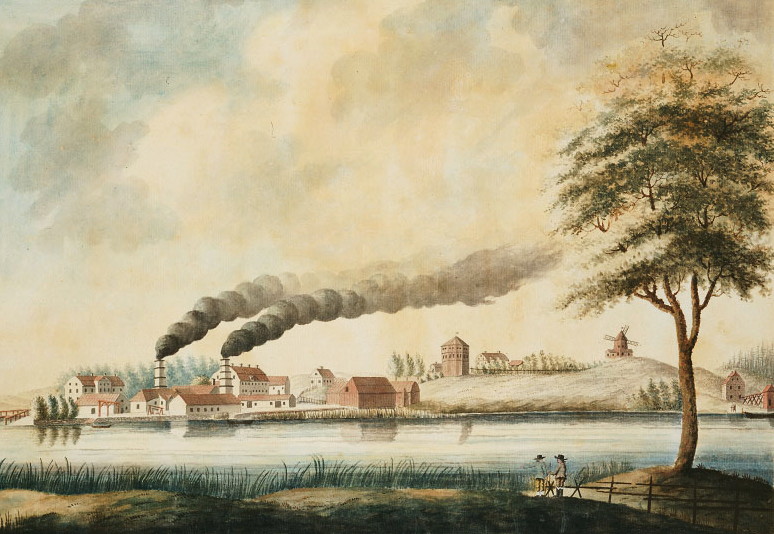
Robert Fulton’s success with steam-powered ships on the Hudson River has sparked interest in canals, because it eliminates the need for horse-drawn carriages along the shore. Baltzar von Platen , a rebel among the men of 1809, was given permission in May to dig for the Göta Canal with soldiers.
Next to Bergsund’s foundry is Långholmen’s spinning house, where the lady-in-waiting Magdalena Rudenschöld was imprisoned from 1794 to 1796 for conspiring with her lover Gustav Mauritz Armfelt against the regent government of Charles XIII. Before that, she was hanged at the pillory on Riddarhustorget.
”With his cold face, he has a very sensitive mind and great integrity. The more you get to know him, the more you like him; he is one of those rare and reliable people that our era only produces sparingly.” Gustavian Armfelt, since 1809 one of the lords of the realm in the government of Charles XIII) about his friend Axel von Fersen. (Armfelt disapproved of the choice of Bernadotte as heir to the throne. He was exiled to Finland in 1811 to serve Emperor Alexander).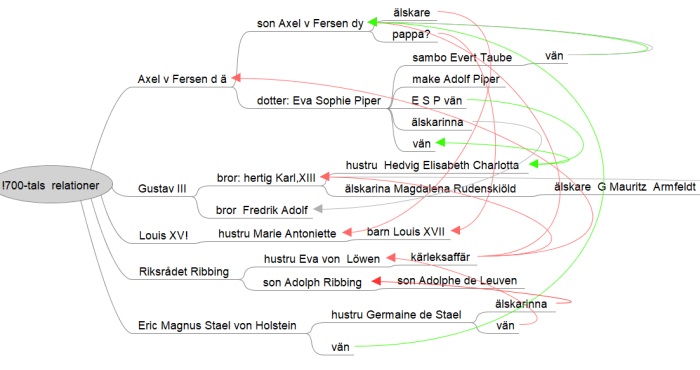
At the site where Högalid Church stands today, Kristinehov’s ore farm is surrounded by gardens and orangeries. The farm was donated to the Borgerskapets Gubbhus and is being rebuilt for poor citizens.
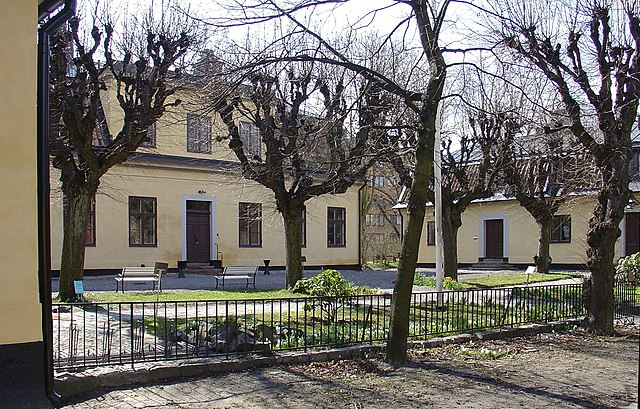
Spectators line Horntullsgatan, a sparsely populated area with gardens and a few houses. Silence is ordered by the governor. Even in the noise, it is difficult to distinguish the cheers and howls of the crowd.

On the bare mountain, windmill blades spin in the wind (Högalidskyrkan today). The town with stone houses appears and the train turns off towards Hornsgtan, which for Kristinehov does not reach further west.
The sly Duke Karl, since June 6th King Karl XIII, is not on the train. He and the ministers are in council at Haga Castle to handle simple matters. The one in charge is General Carl Johan Adlercreutz, the mastermind behind the coup d’état and appointed Minister of State May. Consequently, a sworn enemy of the Gustavians, which strengthens the suspicion of who was ultimately behind the campaign of incitement against Count Fersen. The king and the government do not leave Haga until four o’clock.
Stop 4. Hornsgatan 49-39. The swamp at the swamp takes revenge on the Högväl residents
From Adolf Fredriks Torg (Mariatorget), the funeral procession can be seen approaching Hornsgatan near Swedenborg’s ore farm. The drivers up on the carriage trestles can see his garden and gazebo on the other side of the plank.
The reins must be held tight because the crowd along the street does not give much room for passage. Especially as the horses are frightened by rubbish thrown from the windows. Unclear and there is cheering or swearing, Fersen becomes aware of it later when coins are thrown at the windows and maybe it was also dung. Except for Emauel Swedenborg, but he was asleep from a stroke, in London 1772
There is more room to maneuver past Adolf Fredrik’s Square. Not plantations like today’s Mariatorg but a gravel field where the military exercised. Fersen had worn knight’s armor and participated in the magnificent jousting that Gustav II arranged on the square in the summer of 1777. Before he set off as an officer in Europe, and participated on the French side in the American War of Independence. Interspersed with a series of women’s affairs, including the Swedish queen Hedvig Charlotta and France’s Marie Antoinette.
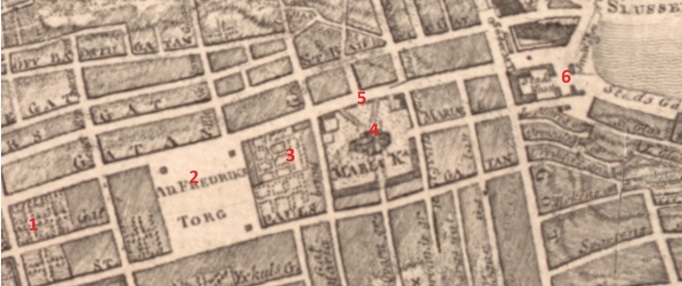
Drum rolls are heard as the funeral procession approaches. The line thickens along the street and more people are seen in the windows. ”King killer” is chanted like a messenger along the street. Copper coins bounce against the windows of Fersen’s seven-glass carriage. Spittoons get stuck on the carriage’s gilded ornaments.
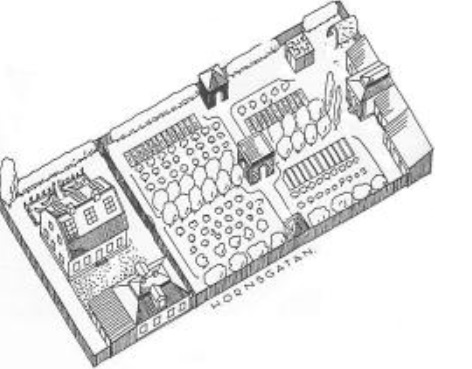
If the wind is blowing, you can smell the smell of the Fatburen swamp in your nostrils. The city’s poorest, sometimes severely affected by plague and cholera due to the well water, encounter aristocratic opulence at Hornsgatan.
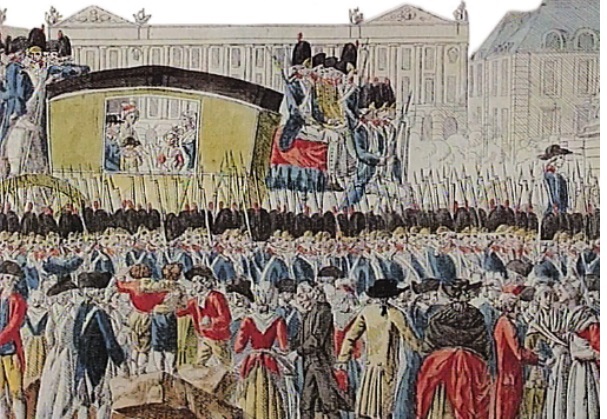
On the anniversary 18 years earlier, Fersen himself was disguised as a coachman on his way out of Paris with the royal family. When they were arrested near the Belgian border, von Fersen had already fled to Brussels.
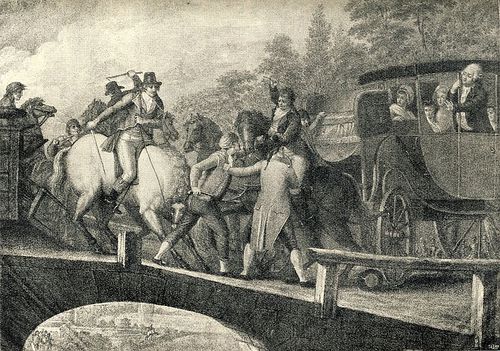
Stop 4. Mariatorget /Adolf Fredriks torg. Poor neighborhoods around a gravel field
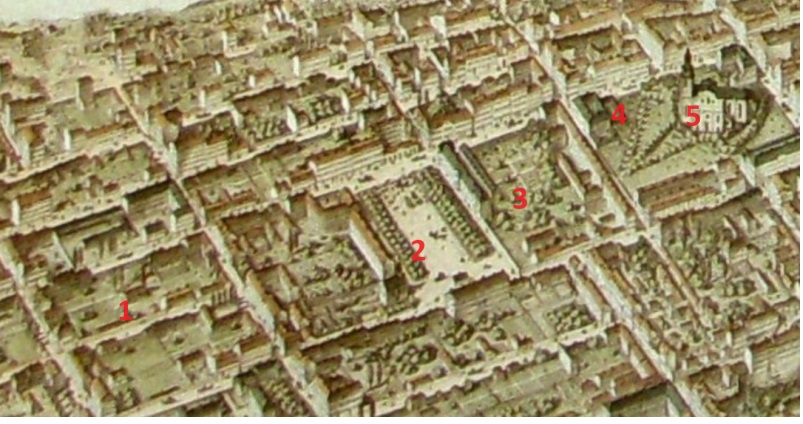
Boys arm themselves in Adolf Fredrik’s Square with garbage and dung, several are found after horses and cattle. The Life Guards and the court’s vehicles are allowed to pass until they scream and throw stones at von Fersen’s carriage. A stone breaks the glass at the right rear wheel. Without the military intervening. Admittedly, their weapons are unloaded. But some riders from the Life Guards had easily protected the seven-glass carriage from the mob. In addition to the four mounted adjutants, the hearse was surrounded by 24 courtiers on foot. It seems that no one intervened.

Axel’s brother Fabian von Fersen sits in a court carriage for a long time, but he doesn’t intervene either. No orders are given from Adjutant General Liljensparre, who rides in the lead and is responsible for order.

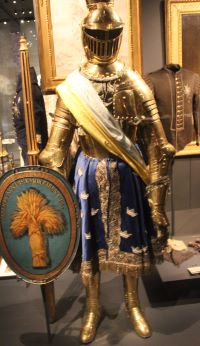
The square brings back memories for von Fersen. Wearing knightly armor, he participated in a jousting match in the square, on Gustav III’s team against the team led by his brother Duke Karl.
More about the love story of von Fersen and Marie Antoninette. Click to StockholmsMix .
They happened in the summer of 1777, when Axel was 22 years old. Yet he had managed to complete a grand tour of Europe: military school in Germany, language training in London and, in French court life, making his first acquaintance with Queen Marie Antoinette.
Adolf Fredriks Torg did not have much more use than military exercises at this time, except as a fire escape – a wise decision after the great Södermalm fire of 1759.
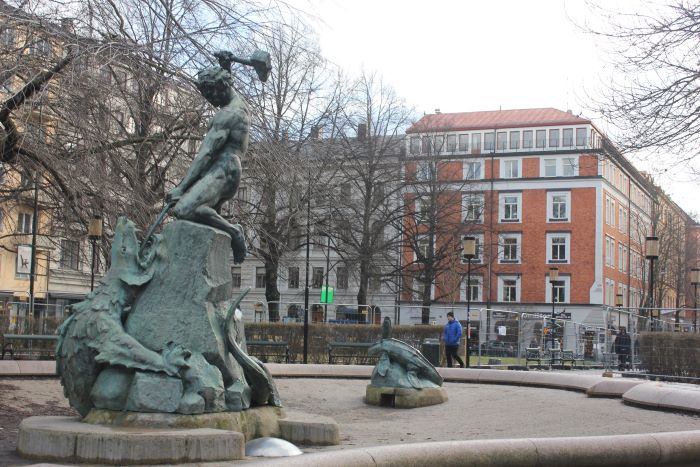
In 1820 and perhaps also in 1810, a long-bearded original, the Goat Man, appeared on the market square. He sells goat milk, which is said to cure lung cancer. Ekström is accompanied by the goats that he herds to the meadows by Sinken’s pond; dressed in goatskin, biblically like an altarpiece. The money is needed because the reputation of stealing the clothes of the dead got him fired as a gravedigger at Maria cemetery.
More about the goat Ekström in StockholmsMix. Click.
Stop 5. Hornbackspuckeln and Maria Magdalen Church, in Bellman’s neighborhood
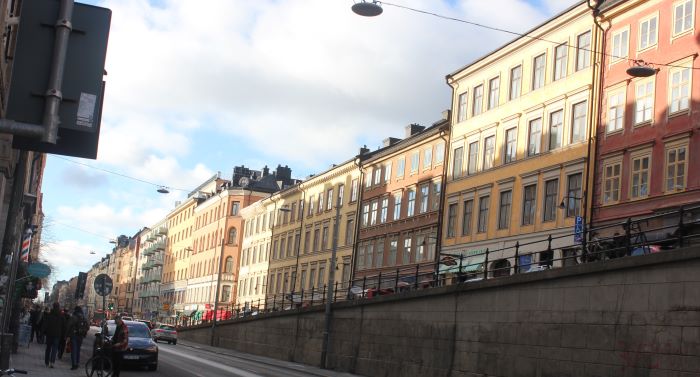
The church bells ring, first Catherine and then Mary Magdalene. The remains of the orngatshumpel we see today show how cramped Hornsgatan was at that time. Notice Hans Marschalck’s house at number 4, with the portal on the staircase gable, restored to its original appearance in 1810 and built in the 17th century by the wise man Marschalk.

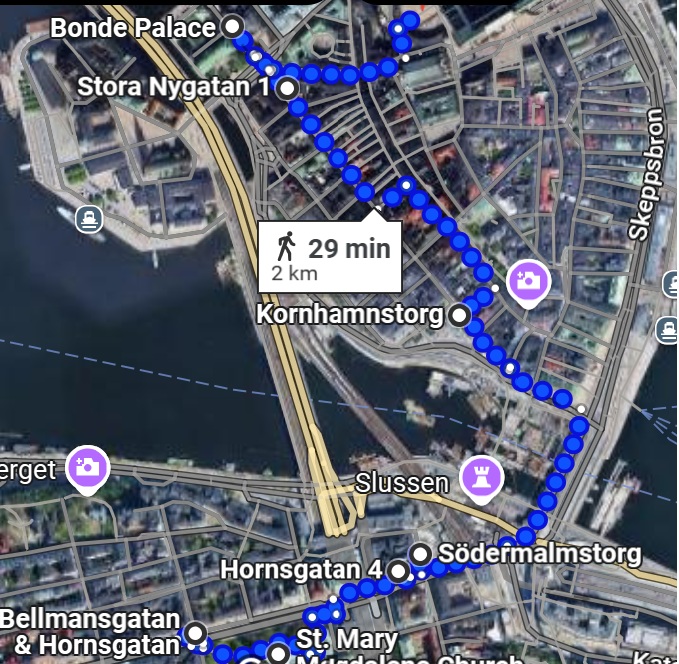
The funeral procession makes its way past thousands of people who are leaning against the walls. Many have been treated to free booze at the taverns, it is unclear who paid. The Hornsbacken slope down towards Södermalm Square is so steep that the drivers have to pull on the brakes.
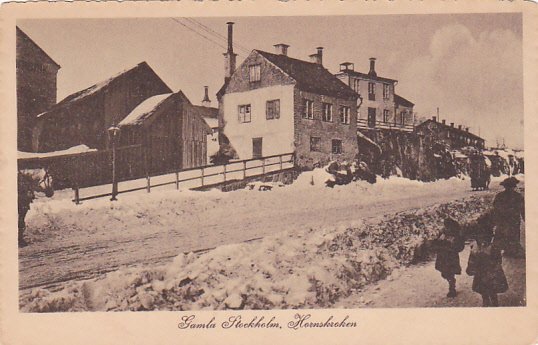
The gutter that was blown up for the trams in 1901 ate up several houses, ”Bellmans” among others. Michael saw the light of day in the house on the corner of Hornsgatan and Bellmansgatan. At that time it was called Björngårdsbrunnsgatan after the well and in distant times Björngården, then known for animal incitements.

The Daurerska Malmgården fills the entire block, with the large house where Bellman was born. Later in his childhood, he grew up in the small house in the block on St Paulsgatan, where his parents moved. Christoffer Polhem lived in the large house to be close to the lock construction near Södermalmstorg.
The church bells in Maria Magdalena try to drown out the street alarm. Boys throw stones at Fersen’s carriage. Judging by the clothes they seem to come from the poorhouses next to Dauerska malmgården, which fills the block between the church and Adolf Fredriks torg. The Bellman family with little Michael lived in the house for a while, hence the name Bellmansgtan from the former Maria Brunnsgränd.
After Bellman, Christoffer Polhem moved into the house to be close to the lock construction at Ryssgården. Polhem died in 1751 and the houses disappeared in 1759 with the great Södermalm fire that started here.

Did von Fersen like the Bellman? Father Fersen, the elder, called him a jester. Younger Fersen frequented the Blå Porten tavern on Djurgården, which speaks for listening to the troubadour’s poetry. ”Mother, I come with the lantern lit, With my glass, with my French horn and the bassoon strung .” From Fredman’s epistle no. 28 Concerning the fight at the ball at Blå Porten.
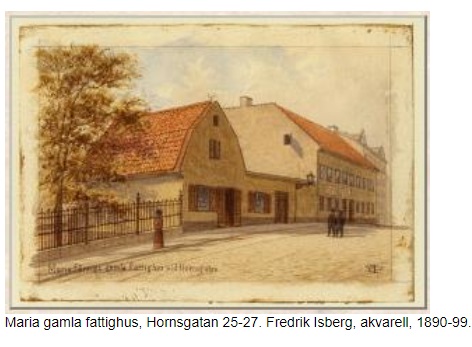
The crowd becomes increasingly violent, perhaps because many come from the parish poorhouse. In front of the cemetery wall, a stone flies through the carriage window. Not even the four lackeys next to the carriage seem to come to Fersen’s aid.
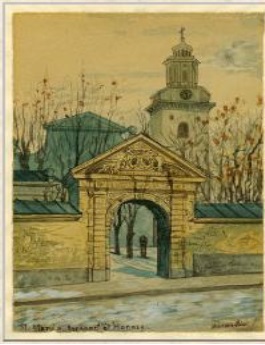
The poets Stagnelius and Lasse Lucidor enjoy their final rest in the cemetery. Christoffer Polhem and Bellman’s singing wife Ulla Winblad, Maria Kristina Kiellström, are also buried here.
Stop 6. Södermalmstorg and the drawbridge, the threshold to the Old Town
The boys’ groups became bolder down towards Södermalmstorg. Pointing fingers outside the count’s window and shouting ” Hurray for Fersen, the crown prince’s murderer .” Fersen reaches out through the rear carriage window like a crushed stone – and asks to be spared.
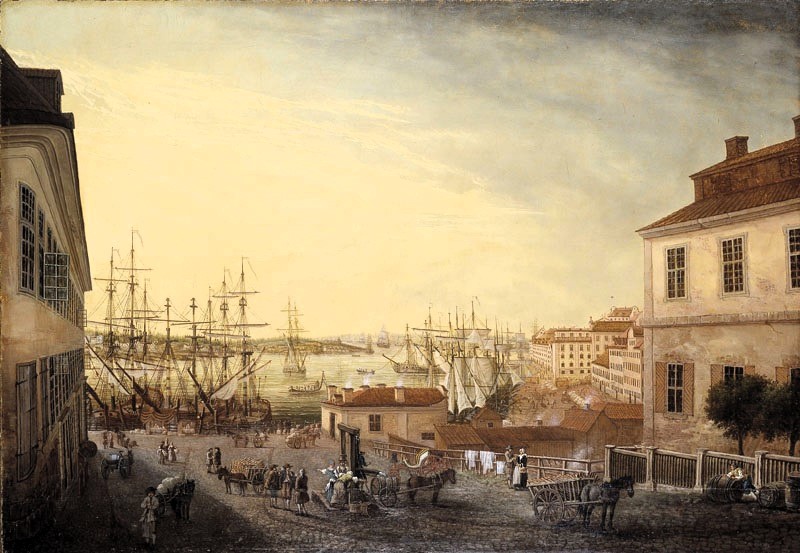
The ravine increases closer to the lock and over the drawbridge, which slows down the procession’s progress. Boys hang on to the break chains but fail to stop the procession.
Doctor Rossi’s carriage is also surrounded, because the Italian is suspected of having poisoned the crown prince on the orders of the Fersen siblings. ”There sits the Fox!” they shout. Everyone knows the fable in the flyers taken from Nya Posten a week earlier. The fox and the female fox are the Fersen siblings, where the crown prince is the male lion.
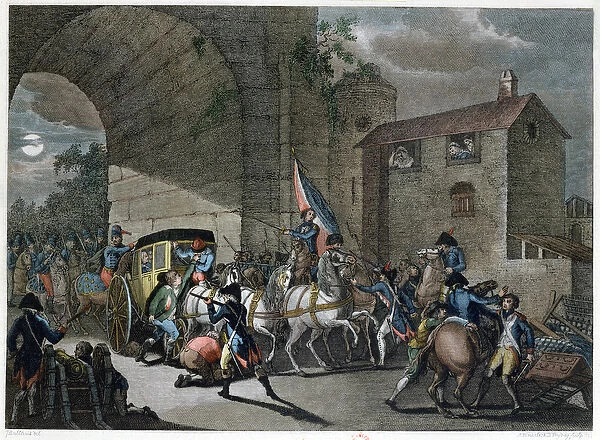
Perhaps Fersen was struck by the memory of 1792 when the French royal family was captured. It happened in 1792 at Varennes near the Belgian border, with a wheel damaged in the bridge abutment. Fersen had rented the carriage and sat dressed as a coachman during the escape from Paris. Although Fersen had left the refugees before Varennes, with the promise of a reunion in Brussels.
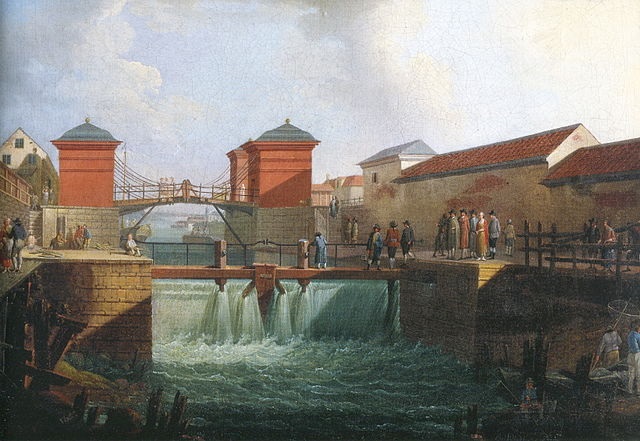
Stop 7. Kornshamstorg. Massacre with sticks, sticks and silk umbrellas

Usually stalls selling fish and agricultural products. Along with emptying latrines at the quay. This day packed with people waiting for the funeral procession. The ringing from the Great Church, the German Church and the Riddarholm Church is mixed with mournful music from the bands. Overshadowed by the shouts from the crowds as the procession approaches. Shouts of ”stones for Fersen” are mixed with ”murderers” .
There are plenty of logs and large stones thrown at the wagon. The windows are broken and Fersen, seemingly bleeding, takes cover in a corner. The driver, Bauer, is hit, falls down and pulls himself up again.
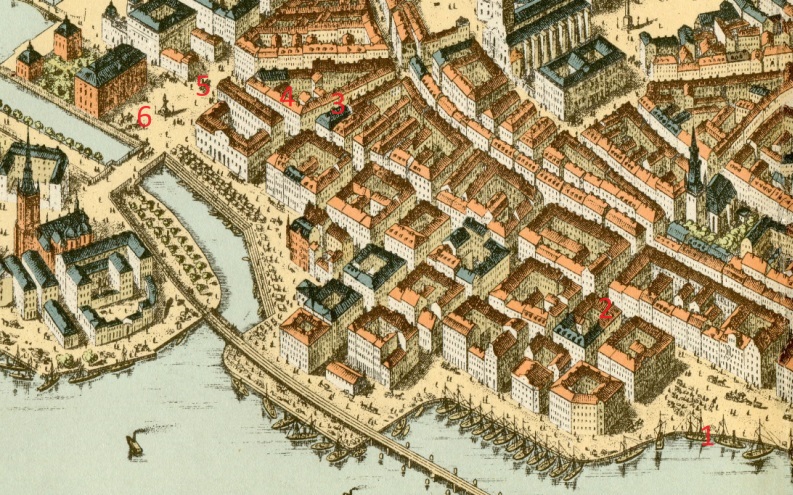
On the narrow Nygatan, the carriage is subjected to a hail of stones and wood, even from above the windows and roof. People grab the sides and whip with sticks, even silk umbrellas from better people. The roof with the count’s crown is battered. No one in front or behind Fersen’s carriage comes to help.
At Kåkbrinken, a person dressed as a sailor thrusts a stick through the window, hitting the count’s head. With the cry, ”You shaky rascal, you haven’t escaped us yet.”
More about the waste management from, among others, Kornhamen in StockholmsMix. Click
Stop 8. Stora Nygatan 1 at Gråmunkegatan. The body is being chased, the funeral procession continues
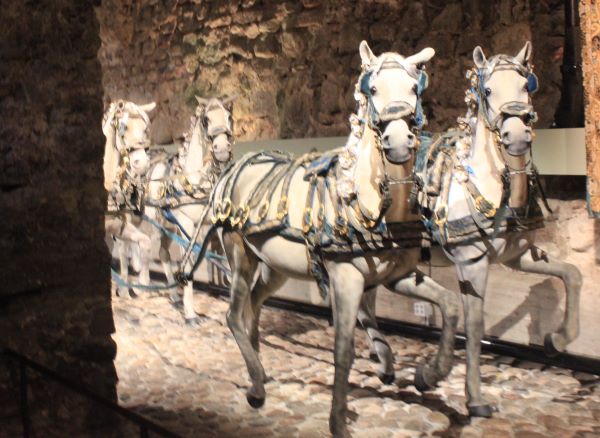
Fersen is bleeding and urges the coachman to hurry up the horses, almost in the guise of all the commotion. At Stora Gråmunkegränd the train stalls before abruptly slowing down towards Storkyrkobrinken. Men dressed as sailors grab the reins, the horses are released from the tow ropes. The coachman Bauer is pulled unconscious from the coachman’s box.

The house we see in the middle of the block north of Gråmunkegränd was then owned by Jonas Hultgren, chamberlain to the dowager queen. An inn upstairs with apartments above.

Fersen, who has crouched under his black coat, is helped out of the carriage by a cadet and pushes his way through the hail of stones into Hultgrenshuset. It is unclear whether the actor Josef Lambert is helping Fersen or insulting him. (He was sentenced to 28 days of bread and water for this and was banished from Stockholm. This also put an end to his comic acting on Djurgården).

The horses are put back in front of the carriage, the coachman wakes up and enters the carriage. Which is led by the master of the stable up Storkyrkobrinken to the Castle, with the crowds following him. (The coachman then hides in Fersen’s palace on Blasieholmen).
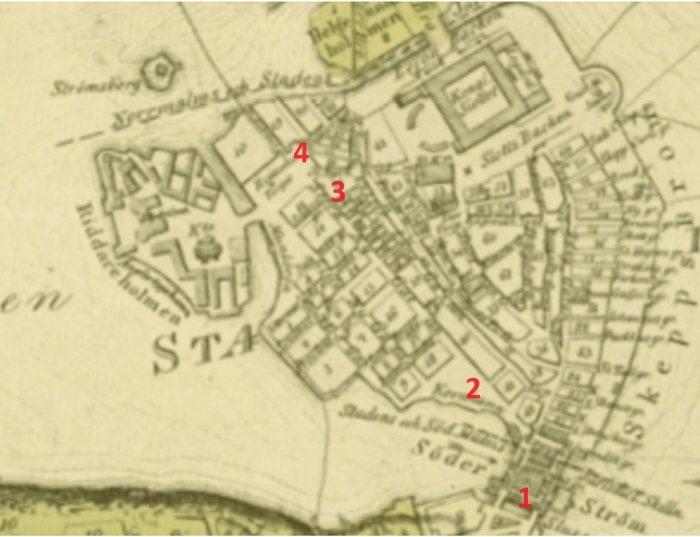
Fersen is led up the stairs to the tavern, filled with spectators at the windows facing Stora Nygatan. He hides in a chamber facing the courtyard. Where people get from Storkyrkobrinekn undetected instead of from Nygatan where hussars are guarding.

A commotion ensues as the angry crowd breaks through the door. Clothes and the ribbon are thrown out the window. Long hair is torn off and Fersen is injured.
From the castle, the adjutant general Silversparre rides to Nygatan, tries to calm the mob and rushes up to Fersen in the chamber. With a promise to arrest Fersen, he is led out into the street without any blows. One of the cries “he shall be broken” comes from a drunken Finnish sailor, according to the rumor, the nobleman Tandefeldt
Stop 9. Riddarhusplan. The Deathstroke.

Von Fersen seeks shelter in the Bondeska Palace but the crowd forces him out. The beating continues in the square. He bleeds and falls to the ground where a man jumps on his chest, the nobleman Tandefelt as it was alleged. The Life Guards are stationed in the square but do not intervene.

Stop 10. Hall of Knights Stockholm Palace. Stormy wake

The funeral procession parks in the courtyard. Karl August is dressed in a black seraphic robe and laid to rest in the procession in the seraphic hall.

At 4 o’clock King Charles arrives from Haga, convenes the Council of State and calls in more troops. Great nervousness, fear of riots that preceded the French Revolution. An estimated 6,000 soldiers guard the streets and squares. The castle gates are barred again. Outside, the guard is attacked with clubs and stones. Cannons are pulled out into the streets. Some are killed and a number are injured, including among the military. The pouring rain calms the masses.
Despite guards standing outside the castle with loaded rifles, a commotion ensues, described in Queen Hedvig Charlotte’s diary.

Even at the coffin in the Seraphim Hall, there are fears of a massacre. The actor Lambert, wholesaler Lexow and physician Rossi are among the many who are arrested. Although no suspicions are directed against the authorities who incited the masses against Fersen. That is, the Mannerheim League, as the men of 1809 are also called.
On June 27, the lid is screwed onto the coffin and it is taken for burial to Riddarholm Church.
/ By Ingemar Lindmark
